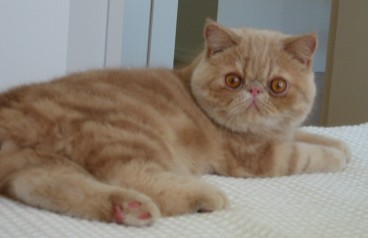- Exotic Shorthair
Infobox Catbreed
name = Exotic Shorthair

imagecaption = Cream tabby male exotic shorthair
country =United States
aacestd = http://www.aaceinc.org/pages/breeds/exo.htm
cfastd = http://www.cfainc.org/breeds/standards/exotic.html
ticastd = http://www.tica.org/binary/pdf/publications/standards/psbrdgrpstd.pdf
fifestd = http://fifeweb.org/wp/breeds/std/exo_std.htmlBreeders crossed the American Shorthair with the Persian in the United States around 1960. Thus were born shorthaired Persians, called Exotic Shorthairs and recognized by the C.F.A in 1966. During the breeding program, crosses were also made with the Russian Blue and the Burmese. Since 1987, the only allowable outcross breed is the Persian. The F.I.Fe. recognized the Exotic Shorthair in 1986.They have nearly the same body as the Persian, but a thick, dense short coat. They appeal to people who like the personality of a Persian but do not want the hassle of grooming a long-haired cat. They are also known as "The Lazy Man's Persian."Appearance
The Exotic has a compact, rounded, powerfully-built body with a short, thick "
linebacker " neck. Its large round eyes, short snub nose, sweet facial expression, and small ears give it a highly neotenic appearance that many people consider cute.Description
Head:Round, massive. Very broad skull. Rounded forehead. Round, full cheeks. Short, broad, round muzzle. Short, broad nose with pronounced stop. Strong chin. Broad, powerful jaws.
Ears:Small, rounded at the tip, not too open at the base. Widely spaced and well-furnished with hair on the inside.
Eyes:Large, round, well-spaced. Pure, deep color corresponding to that of the coat (gold to copper in most varieties; green in the chinchilla and the golden; blue in the white and the colorpoint).
Neck:Short and thick.
Body:Medium in size, cobby, low to the ground. Broad chest. Massive shoulders. Large-boned, powerful muscles. Weight: 3,5 - 6 kilogram.
Paw:Short, straight, and large. Round, large paws. Tufts of hair between the toes are desirable.
Tail:Short, thick, carried low. Rounded tip.
Coat:Shorthaired but slightly longer than that of other shorthaired breeds. Dense, fluffy, erect hair. All Persian colors are recognized.
Character
The Exotic Shorthair has a gentle and calm personality reminiscent of the Persian, but it is livelier than his longhaired ancestor. Curious and playful, it is friendly to other cats and dogs. it rarely meows. it doesn’t like being left alone, and needs the presence of its owner (or of voices or smells reminiscent of its master-such as a radio kept on). They tend to show more
affection andloyalty than most breeds and make excellent lap cats. Their calm and steady nature makes them ideal apartment cats for city dwellers. Nonetheless, Exotics retain some of the energetic spark of their American Shorthair forbears and they are often capablemouse hunters.Care and grooming
Unlike the high-maintenance Persian, the Exotic is able to keep its own
fur tidy with little human assistance, though weekly brushing and combing is recommended to remove loose hair and reduce shedding andhairball s.As with other flat-faced animals, the Exotic's
tears are prone to overflowing thenasolacrimal duct , dampening and staining the face. This can be relieved by periodically wiping the cat's face with a cloth moistened withwater or one of the commercial preparations made expressly for the purpose.This robust and healthy breed does not reach maturity until around two years of age and enters puberty fairly late. When two Exotic Shorthairs are crossed, they may produce longhaired kittens called “Exotic Longhairs” by the C.F.A. but considered Persian by other registering bodies. Externally they look like Persians.
Health
* Feline polycystic kidney disease (PKD). Exotic shorthairs as is the case of Persians and other Persian derived cats have a high chance of inheriting PKD, a disease that can lead to kidney failure. Sevaral studies using ultrasound scan screening has shown that the prevalence of PKD in exotics is between 40 and 50% in developed nations. [cite journal |author=Cannon MJ, MacKay AD, Barr FJ, Rudorf H, Bradley KJ, Gruffydd-Jones TJ |title=Prevalence of polycystic kidney disease in Persian cats in the United Kingdom |journal=Vet. Rec. |volume=149 |issue=14 |pages=409–11 |year=2001 |month=October |pmid=11678212 |doi=10.1016/S1098-612X(03)00052-4 |url=]
References
External links
* [http://Exotic-directory.atspace.com Worldwide Exotic Shorthair Breeders Directory]
Wikimedia Foundation. 2010.
